Preparation and Properties of Wood Tar-based Rejuvenated Asphalt
Abstract
1. Introduction
2. Materials and Experiments
2.1. Materials
2.1.1. Raw Materials
2.1.2. Aged Asphalt
2.1.3. Rejuvenated Asphalt
2.2. Sample Preparation
2.3. Experiments
2.3.1. Penetration
2.3.2. Softening Point
2.3.3. Ductility
2.3.4. Viscosity
2.3.5. Complex Modulus and Phase Angle
2.3.6. Creep Stiffness and Creep Rate
2.3.7. Component Analysis (SARA)
2.3.8. Fourier Transform Infrared Spectroscopy (FTIR)
3. Optimal Ratio of Wood Tar-Based Rejuvenator
3.1. Orthogonal Test Combination
3.2. Penetration
3.3. Softening Point
3.4. Ductility
3.5. Viscosity
4. Results and Discussion
4.1. Physical Properties
4.2. Rheological Properties
4.2.1. High-Temperature Property
4.2.2. Low-Temperature Property
4.3. Compositions
4.3.1. Component Analysis
4.3.2. FTIR
5. Conclusions
6. Future Work
- (1)
- Further clarify the impact of wood tar from other biomass sources (such as pine, fir, etc.) on the performance recovery of aged asphalt, and broaden the range of wood tar materials to optimize its rejuvenation effect;
- (2)
- The ductility, low-temperature crack resistance, and fatigue resistance of wood tar-based rejuvenated asphalt can be further improved by introducing appropriate additives (such as SBS);
- (3)
- Explore the molecular structure and chemical composition of wood tar to meet the rejuvenation needs of different types of aged asphalt (matrix asphalt, SBS modified asphalt, etc.);
- (4)
- Evaluate the road performance of wood tar-based rejuvenated asphalt mixture;
- (5)
- Evaluate the energy consumption, cost, and environmental impact in the preparation and use of wood tar-based rejuvenated asphalt and its mixture.
Author Contributions
Funding
Conflicts of Interest
References
- Su, N.; Xiao, F.; Wang, J.; Cong, L.; Amirkhanian, S. Productions and applications of bio-asphalts–A review. Constr. Build. Mater. 2018, 183, 578–591. [Google Scholar] [CrossRef]
- Siddiqui, M.N.; Ali, M.F. Investigation of chemical transformations by NMR and GPC during the laboratory aging of Arabian asphalt. Fuel 1999, 78, 1407–1416. [Google Scholar] [CrossRef]
- Ahmed, R.B.; Hossain, K. Waste cooking oil as an asphalt rejuvenator: A state-of-the-art review. Constr. Build. Mater. 2020, 230, 116985. [Google Scholar] [CrossRef]
- Liu, M.; Ferry, M.A.; Davison, R.R.; Glover, C.J.; Bullin, J.A. Oxygen uptake as correlated to carbonyl growth in aged asphalts and asphalt Corbett fractions. Ind. Eng. Chem. Res. 1998, 37, 4669–4674. [Google Scholar] [CrossRef]
- Zaumanis, M.; Mallick, R.B.; Frank, R. Determining optimum rejuvenator dose for asphalt recycling based on Superpave performance grade specifications. Constr. Build. Mater. 2014, 69, 159–166. [Google Scholar] [CrossRef]
- Zhang, L.; Hussain, B.; Tan, Y.Q.; Cheng, L. Mechanism of low-and intermediate-temperature performance improvement of reclaimed oil-modified asphalt. Road Mater. Pavement Des. 2018, 19, 1301–1313. [Google Scholar]
- Qiu, Y.J.; Ding, H.B.; Rahman, A.; Wang, W.Q. Damage characteristics of waste engine oil bottom rejuvenated asphalt binder in the non-linear range and its microstructure. Constr. Build. Mater. 2018, 174, 202–209. [Google Scholar] [CrossRef]
- Vidal, R.; Moliner, E.; Martínez, G.; Rubio, M.C. Life cycle assessment of hot mix asphalt and zeolite-based warm mix asphalt with reclaimed asphalt pavement. Resour. Conserv. Recycl. 2013, 74, 101–114. [Google Scholar] [CrossRef]
- Ongel, A.; Hugener, M. Impact of rejuvenators on aging properties of bitumen. Constr. Build. Mater. 2015, 94, 467–474. [Google Scholar] [CrossRef]
- Sargious, M.; Mushule, N. Behaviour of recycled asphalt pavements at low temperatures. Can. J. Civ. Eng. 1991, 18, 428–435. [Google Scholar] [CrossRef]
- Wu, S.P.; Huang, X.M.; Zhao, Y.L. The development of recycling agent for asphalt pavement. J. Wuhan Univ. Technol. 2002, 17, 63–65. [Google Scholar]
- García, Á.; Schlangen, E.; van de Ven, M.; Sierra-Beltrán, G. Preparation of capsules containing rejuvenators for their use in asphalt concrete. J. Hazard. Mater. 2010, 184, 603–611. [Google Scholar] [CrossRef] [PubMed]
- Chen, M.Z.; Leng, B.B.; Wu, S.P.; Sang, Y. Physical, chemical and rheological properties of waste edible vegetable oil rejuvenated asphalt binders. Constr. Build. Mater. 2014, 66, 286–298. [Google Scholar] [CrossRef]
- Behnood, A. Application of rejuvenators to improve the rheological and mechanical properties of asphalt binders and mixtures: A review. J. Clean. Prod. 2019, 231, 171–182. [Google Scholar] [CrossRef]
- Sun, Z.; Yi, J.; Huang, Y.; Feng, D.; Guo, C. Properties of asphalt binder modified by bio-oil derived from waste cooking oil. Constr. Build. Mater. 2016, 102, 496–504. [Google Scholar] [CrossRef]
- Mohammad, L.N.; Elseifi, M.A.; Cooper, S.B., III; Challa, H.; Naidoo, P. Laboratory evaluation of asphalt mixtures that contain biobinder technologies. Transp. Res. Rec. 2013, 2371, 58–65. [Google Scholar] [CrossRef]
- Hong, W.; Mo, L.T.; Pan, C.L.; Riara, M.; Wei, M.; Zhang, J.Z. Investigation of rejuvenation and modification of aged asphalt binders by using aromatic oil-SBS polymer blend. Constr. Build. Mater. 2020, 231, 117154. [Google Scholar] [CrossRef]
- Cao, X.X.; Cao, X.J.; Tang, B.M.; Wang, Y.Y.; Li, X.L. Investigation on Possibility of Waste Vegetable Oil Rejuvenating Aged Asphalt. Appl. Sci. 2018, 8, 765. [Google Scholar]
- Cardoso, C.A.L.; Machado, M.E.; Caramão, E.B. Characterization of bio-oils obtained from pyrolysis of bocaiuva residues. Renew. Energy 2016, 91, 21–31. [Google Scholar] [CrossRef]
- Kanaujia, P.K.; Sharma, Y.K.; Garg, M.O.; Tripathi, D.; Singh, R. Review of analytical strategies in the production and upgrading of bio-oils derived from lignocellulosic biomass. J. Anal. Appl. Pyrolysis 2014, 105, 55–74. [Google Scholar] [CrossRef]
- Xiu, S.; Shahbazi, A.; Shirley, V.; Cheng, D. Hydrothermal pyrolysis of swine manure to bio-oil: Effects of operating parameters on products yield and characterization of bio-oil. J. Anal. Appl. Pyrol. 2010, 88, 73–79. [Google Scholar] [CrossRef]
- Şensöz, S.; Can, M. Pyrolysis of pine (Pinus brutia Ten.) chips: 1. Effect of pyrolysis temperature and heating rate on the product yields. Energy Sources 2002, 24, 347–355. [Google Scholar]
- Bridgwater, A.V.; Peacocke, G.V.C. Fast pyrolysis processes for biomass. Renew. Sustain. Energy Rev. 2000, 4, 1–73. [Google Scholar] [CrossRef]
- Yu, X.K.; Zaumanis, M.; Santos, S.D.; Poulikakos, L.D. Rheological, microscopic, and chemical characterization of the rejuvenating effect on asphalt binders. Fuel 2014, 135, 162–171. [Google Scholar] [CrossRef]
- Zhang, R.; You, Z.P.; Wang, H.N.; Ye, M.X.; Yap, Y.K.; Si, C.D. The impact of bio-oil as rejuvenator for aged asphalt binder. Constr. Build. Mater. 2019, 196, 134–143. [Google Scholar] [CrossRef]
- Hugener, M.; Partl, M.N.; Morant, M. Cold asphalt recycling with 100% reclaimed asphalt pavement and vegetable oil-based rejuvenators. Road Mater. Pavement Des. 2014, 15, 239–258. [Google Scholar] [CrossRef]
- Zaumanis, M.; Mallick, R.B.; Frank, R. Evaluation of different recycling agents for restoring aged asphalt binder and performance of 100% recycled asphalt. Mater. Struct. 2015, 48, 2475–2488. [Google Scholar] [CrossRef]
- Oldham, D.; Fini, E.; Chailleux, E. Application of a bio-binder as a rejuvenator for wet processed asphalt shingles in pavement construction. Constr. Build. Mater. 2015, 86, 75–84. [Google Scholar] [CrossRef]
- Moghaddam, T.B.; Baaj, H. The use of rejuvenating agents in production of recycled hot mix asphalt: A systematic review. Constr. Build. Mater. 2016, 114, 805–816. [Google Scholar] [CrossRef]
- Xiu, S.; Shahbazi, A. Bio-oil production and upgrading research: A review. Renew. Sustain. Energy Rev. 2012, 16, 4406–4414. [Google Scholar] [CrossRef]
- Mullen, C.A.; Boateng, A.A.; Goldberg, N.M.; Lima, I.M.; Laird, D.A.; Hicks, K.B. Bio-oil and bio-char production from corn cobs and stover by fast pyrolysis. Biomass Bioenergy 2010, 34, 67–74. [Google Scholar] [CrossRef]
- Jung, S.H.; Kang, B.S.; Kim, J.S. Production of bio-oil from rice straw and bamboo sawdust under various reaction conditions in a fast pyrolysis plant equipped with a fluidized bed and a char separation system. J. Anal. Appl. Pyrolysis 2008, 82, 240–247. [Google Scholar] [CrossRef]
- Bridgwater, A.V.; Meier, D.; Radlein, D. An overview of fast pyrolysis of biomass. Org. Geochem. 1999, 30, 1479–1493. [Google Scholar] [CrossRef]
- Abtahi, S.M.; Sheikhzadeh, M.; Hejazi, S.M. Fiber-reinforced asphalt-concrete—A review. Constr. Build. Mater. 2010, 24, 871–877. [Google Scholar] [CrossRef]
- JTG F41-2008. Technical Specifications for Highway Asphalt Pavement Recycling; Ministry of Transport of the People’s Republic of China: Beijing, China, 2008.
- Yang, X.; You, Z.P.; Mills-Beale, J. Asphalt binders blended with a high percentage of biobinders: Aging mechanism using FTIR and rheology. J. Mater. Civ. Eng. 2014, 27, 04014157. [Google Scholar] [CrossRef]
- Fini, E.H.; Kalberer, E.W.; Shahbazi, A.; Basti, M.; You, Z.P.; Ozer, H.; Aurangzeb, Q. Chemical characterization of biobinder from swine manure: Sustainable modifier for asphalt binder. J. Mater. Civ. Eng. 2011, 23, 1506–1513. [Google Scholar] [CrossRef]
- Gong, M.H.; Yang, J.; Zhang, J.Y.; Zhu, H.R.; Tong, T.Z. Physical–chemical properties of aged asphalt rejuvenated by bio-oil derived from biodiesel residue. Constr. Build. Mater. 2016, 105, 35–45. [Google Scholar] [CrossRef]
- JTG E20-2011. Standard Test Methods of Bitumen and Bituminous Mixtures for Highway Engineering; Ministry of Transport of the People’s Republic of China: Beijing, China, 2011.
- Azahar, W.N.A.W.; Jaya, R.P.; Hainin, M.R.; Bujang, M.; Ngadi, N. Chemical modification of waste cooking oil to improve the physical and rheological properties of asphalt binder. Constr. Build. Mater. 2016, 126, 218–226. [Google Scholar] [CrossRef]
- Su, J.F.; Qiu, J.; Schlangen, E.; Wang, Y.Y. Investigation the possibility of a new approach of using microcapsules containing waste cooking oil: In situ rejuvenation for aged bitumen. Constr. Build. Mater. 2015, 74, 83–92. [Google Scholar] [CrossRef]
- Li, H.B.; Liu, G.M.; Dong, B.; Zhao, G.J.; Guo, P.; Huang, J.Y.; Sheng, Y.P. Research on the development and regeneration performance of asphalt rejuvenator based on the mixed waste engine oil and waste cooking oil. Int. J. Pavement Res. Technol. 2019, 12, 336–346. [Google Scholar] [CrossRef]
- Chen, M.Z.; Xiao, F.P.; Putman, B.; Leng, B.B.; Wu, S.P. High temperature properties of rejuvenating recovered binder with rejuvenator, waste cooking and cotton seed oils. Constr. Build. Mater. 2014, 59, 10–16. [Google Scholar] [CrossRef]
- Yang, X.; You, Z.P. High temperature performance evaluation of bio-oil modified asphalt binders using the DSR and MSCR tests. Constr. Build. Mater. 2015, 76, 380–387. [Google Scholar] [CrossRef]
- Zhang, D.; Chen, M.Z.; Wu, S.P.; Liu, J.X.; Amirkhanian, S. Analysis of the relationships between waste cooking oil qualities and rejuvenated asphalt properties. Materials 2017, 10, 508. [Google Scholar] [CrossRef]
- Zargar, M.; Ahmadinia, E.; Asli, H.; Karim, M.R. Investigation of the possibility of using waste cooking oil as a rejuvenating agent for aged bitumen. J. Hazard. Mater. 2012, 233, 254–258. [Google Scholar] [CrossRef] [PubMed]
- Mouillet, V.; Farcas, F.; Besson, S. Ageing by UV radiation of an elastomer modified bitumen. Fuel 2008, 87, 2408–2419. [Google Scholar] [CrossRef]
- Yao, H.; Dai, Q.L.; You, Z.P. Fourier Transform Infrared Spectroscopy characterization of aging-related properties of original and nano-modified asphalt binders. Constr. Build. Mater. 2015, 101, 1078–1087. [Google Scholar] [CrossRef]
- Ghavibazoo, A.; Abdelrahman, M. Composition analysis of crumb rubber during interaction with asphalt and effect on properties of binder. Int. J. Pavement Eng. 2013, 14, 517–530. [Google Scholar] [CrossRef]
- Wei, J.B.; Shull, J.C.; Lee, Y.J.; Hawley, M.C. Characterization of asphalt binders based on chemical and physical properties. Int. J. Polym. Anal. Charact. 1996, 3, 33–58. [Google Scholar] [CrossRef]
- Petersen, J.C.; Plancher, H. Model studies and interpretive review of the competitive adsorption and water displacement of petroleum asphalt chemical functionalities on mineral aggregate surfaces. Pet. Sci. Technol. 1998, 16, 89–131. [Google Scholar] [CrossRef]
- Jia, X.Y.; Huang, B.S.; Moore, J.A.; Zhao, S. Infrared spectra and rheological properties of asphalt cement containing waste engine oil residues. Constr. Build. Mater. 2014, 50, 683–691. [Google Scholar] [CrossRef]
- Ge, Z.S.; Wang, H.; Zhang, Q.S.; Xiong, C.L. Glass fiber reinforced asphalt membrane for interlayer bonding between asphalt overlay and concrete pavement. Constr. Build. Mater. 2015, 101, 918–925. [Google Scholar] [CrossRef]
- Zou, G.L.; Xu, J.; Wu, C. Evaluation of factors that affect rutting resistance of asphalt mixes by orthogonal experiment design. Int. J. Pavement Res. Technol. 2017, 10, 282–288. [Google Scholar] [CrossRef]
- Isahak, W.N.R.W.; Hisham, M.W.M.; Yarmo, M.A.; Hin, T.Y. A review on bio-oil production from biomass by using pyrolysis method. Renew. Sustain. Energy Rev. 2012, 16, 5910–5923. [Google Scholar] [CrossRef]
- Zhang, F.; Hu, C.B. Preparation and properties of high viscosity modified asphalt. Polym. Compos. 2017, 38, 936–946. [Google Scholar] [CrossRef]
- Fernandes, M.R.S.; Forte, M.M.C.; Leite, L.F.M. Rheological evaluation of polymer-modified asphalt binders. Mater. Res. 2008, 11, 381–386. [Google Scholar] [CrossRef]
- Ziari, H.; Moniri, A.; Bahri, P.; Saghafi, Y. The effect of rejuvenators on the aging resistance of recycled asphalt mixtures. Constr. Build. Mater. 2019, 224, 89–98. [Google Scholar] [CrossRef]
- Li, J.; Zhang, F.L.; Liu, Y.; Muhammad, Y.; Su, Z.B.; Meng, F.; Chen, X.Y. Preparation and properties of soybean bio-asphalt/SBS modified petroleum asphalt. Constr. Build. Mater. 2019, 201, 268–277. [Google Scholar] [CrossRef]
- Khattak, M.J.; Khattab, A.; Rizvi, H.R.; Zhang, P.F. The impact of carbon nano-fiber modification on asphalt binder rheology. Constr. Build. Mater. 2012, 30, 257–264. [Google Scholar] [CrossRef]
- Chen, H.X.; Xu, Q.W. Experimental study of fibers in stabilizing and reinforcing asphalt binder. Fuel 2010, 89, 1616–1622. [Google Scholar] [CrossRef]
- Wang, Q.; Yan, P.Y.; Kong, X.M.; Yang, J.B. Compressive strength development and microstructure of cement-asphalt mortar. J. Wuhan Univ. Technol. 2011, 26, 998–1003. [Google Scholar] [CrossRef]
- Mills-Beale, J.; You, Z.P.; Fini, E.; Zada, B.; Lee, C.H.; Yap, Y.K. Aging influence on rheology properties of petroleum-based asphalt modified with biobinder. J. Mater. Civ. Eng. 2012, 26, 358–366. [Google Scholar] [CrossRef]
- Sun, D.Q.; Lu, T.; Xiao, F.P.; Zhu, X.Y.; Sun, G.Q. Formulation and aging resistance of modified bio-asphalt containing high percentage of waste cooking oil residues. J. Clean. Prod. 2017, 161, 1203–1214. [Google Scholar] [CrossRef]
- JTG F40-2004. Technical Specifications for Construction of Highway Asphalt Pavement; Ministry of Transport of the People’s Republic of China: Beijing, China, 2004.
- Jalkh, R.; El-Rassy, H.; Chehab, G.R.; Abiad, M.G. Assessment of the physico-chemical properties of waste cooking oil and spent coffee grounds oil for potential use as asphalt binder rejuvenators. Waste Biomass Valoriz. 2018, 9, 2125–2132. [Google Scholar] [CrossRef]
- Zhang, R.; Wang, H.N.; Gao, J.F.; You, Z.P.; Yang, X. High temperature performance of SBS modified bio-asphalt. Constr. Build. Mater. 2017, 144, 99–105. [Google Scholar] [CrossRef]
- Liu, K.F.; Zhang, K.; Wu, J.L.; Muhunthan, B.; Shi, X.M. Evaluation of mechanical performance and modification mechanism of asphalt modified with graphene oxide and warm mix additives. J. Clean. Prod. 2018, 193, 87–96. [Google Scholar] [CrossRef]
- Bao, D.X.; Yu, Y.Y.; Zhao, Q.M. Evaluation of the chemical composition and rheological properties of bio-asphalt from different biomass sources. Road Mater. Pavement Des. 2019, 1–15. [Google Scholar] [CrossRef]
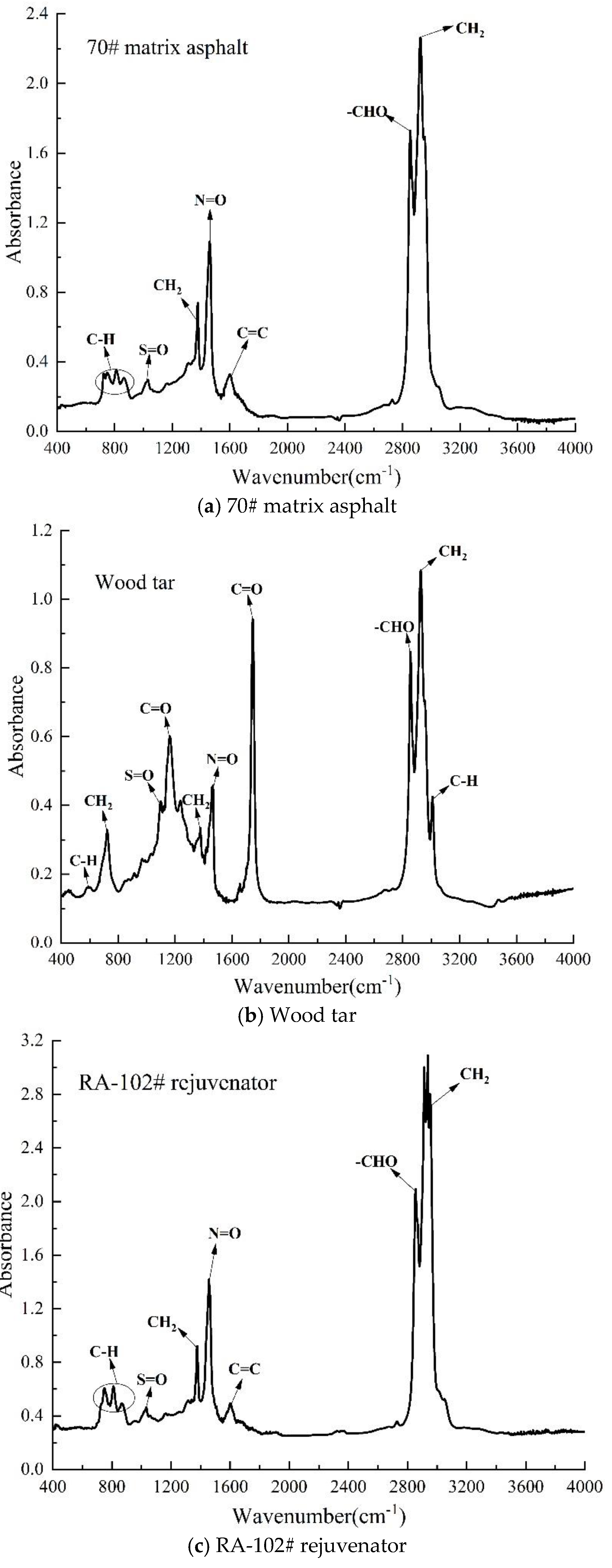
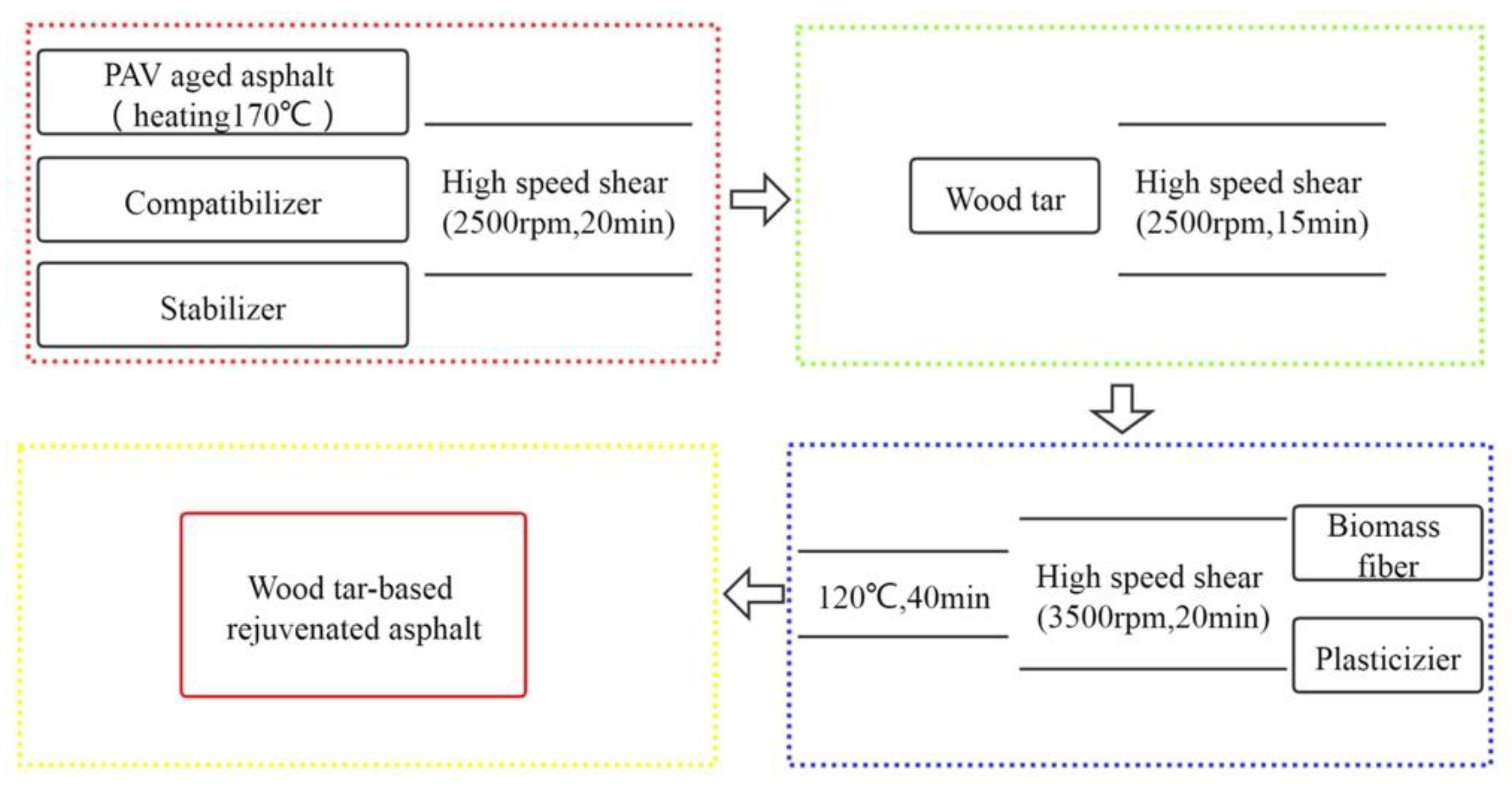
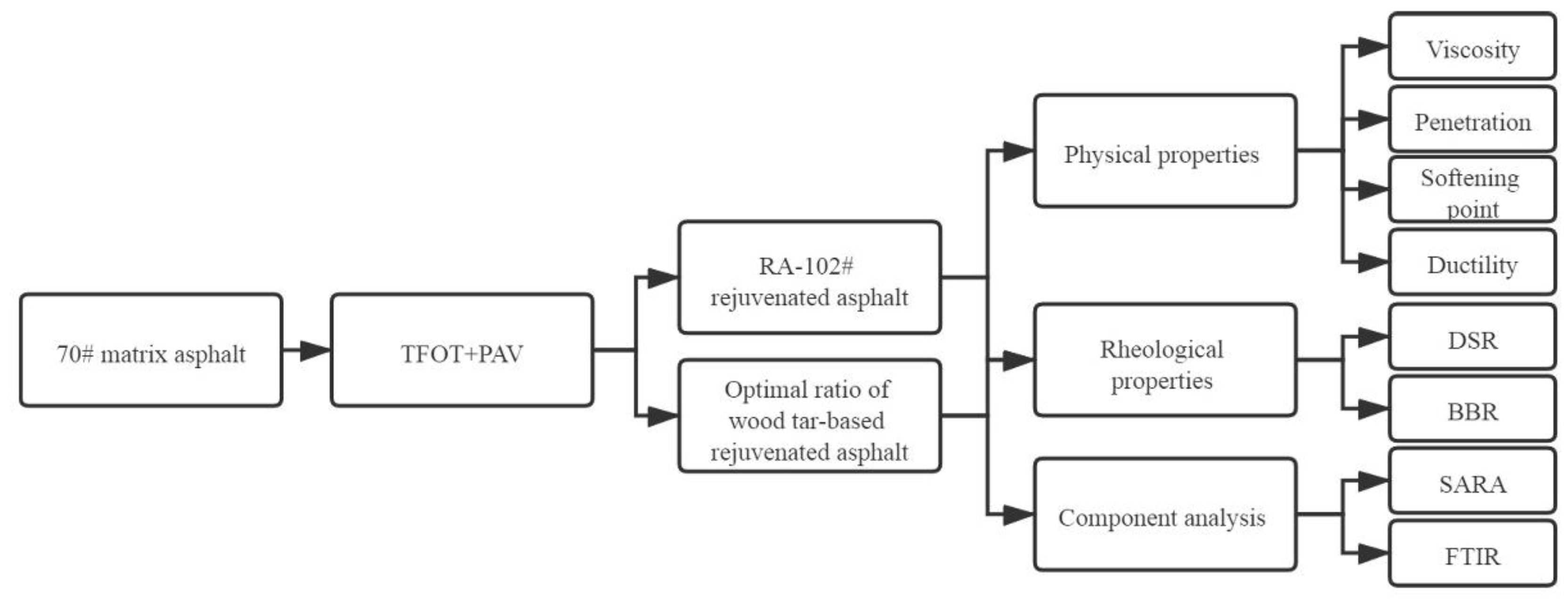
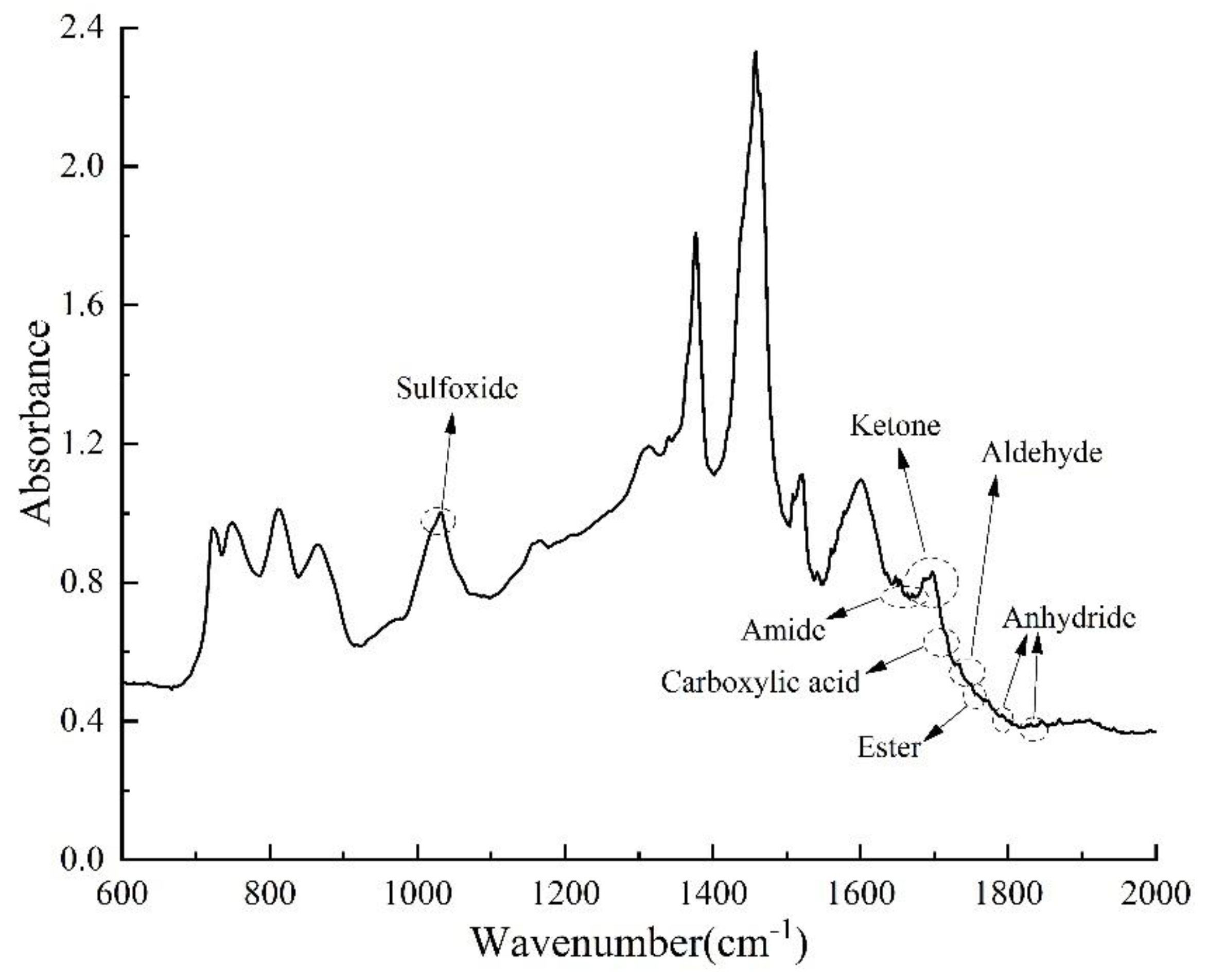


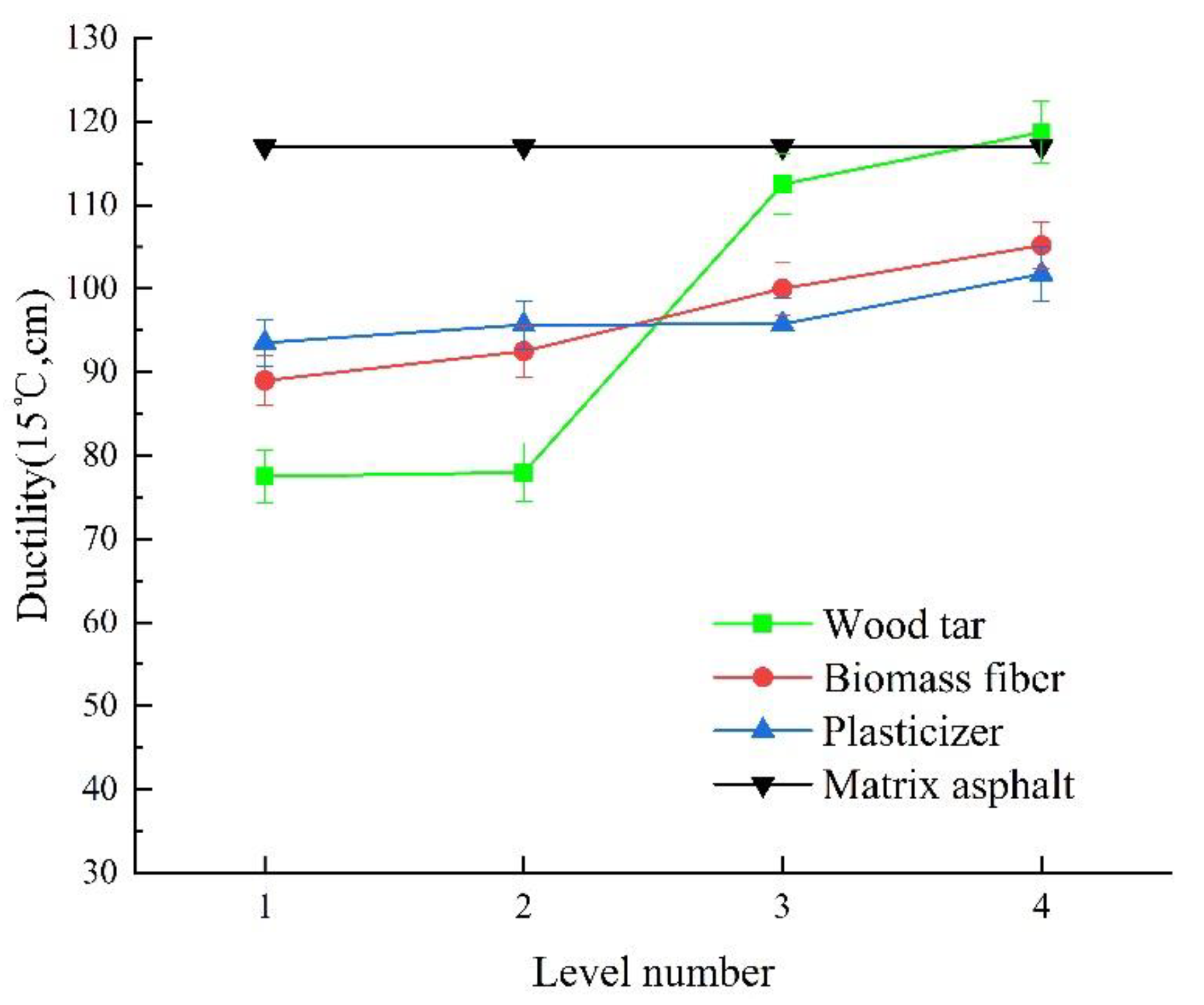
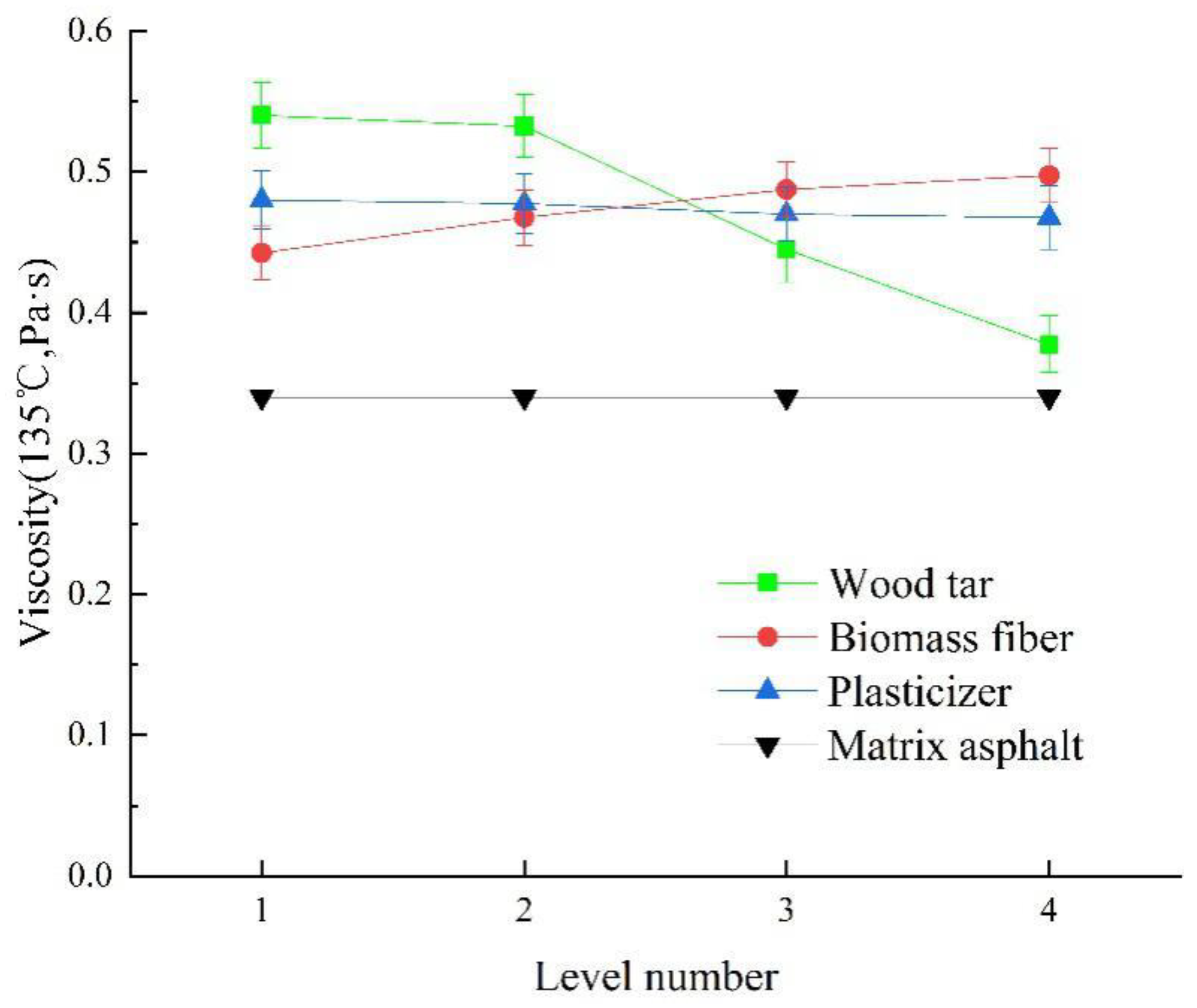
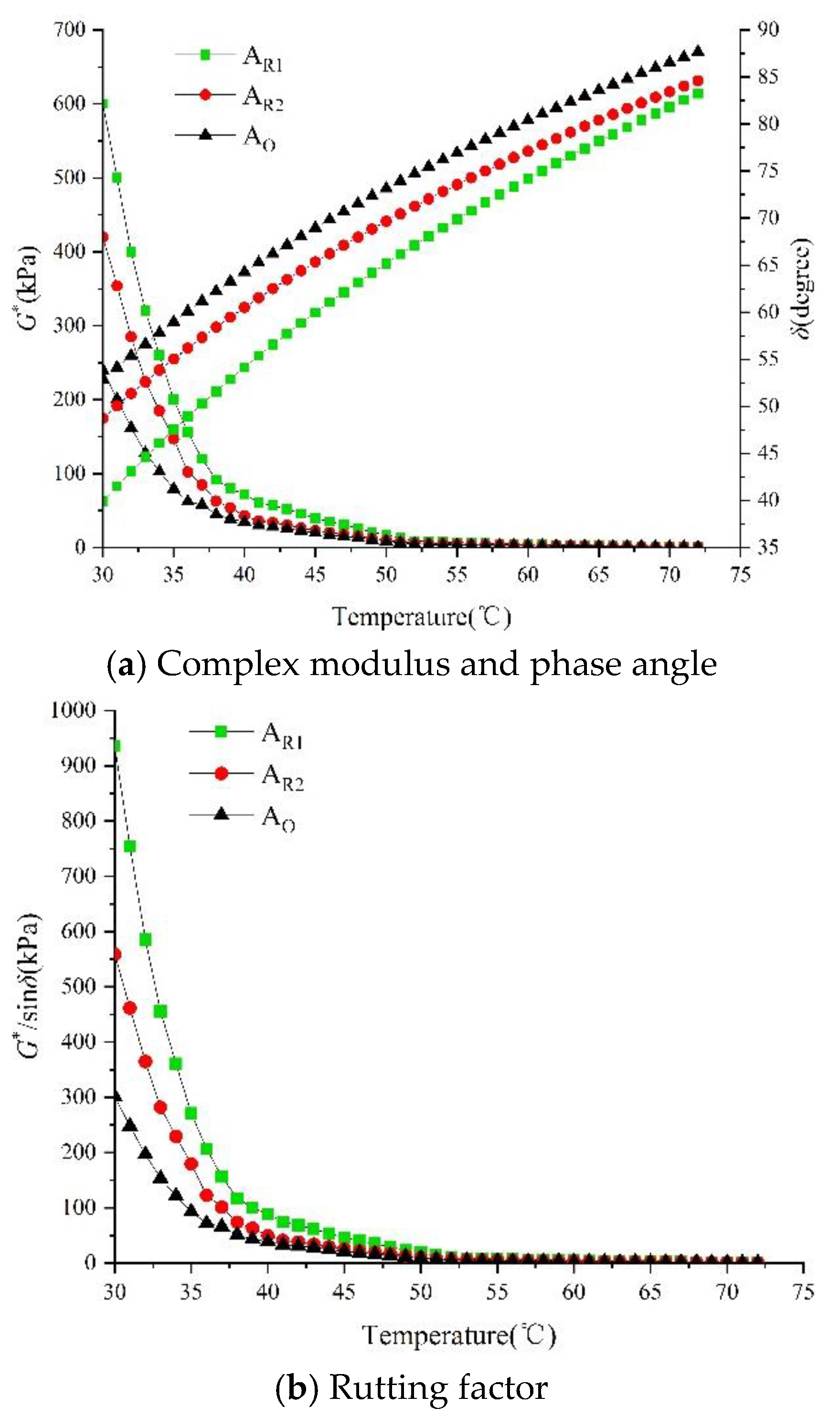
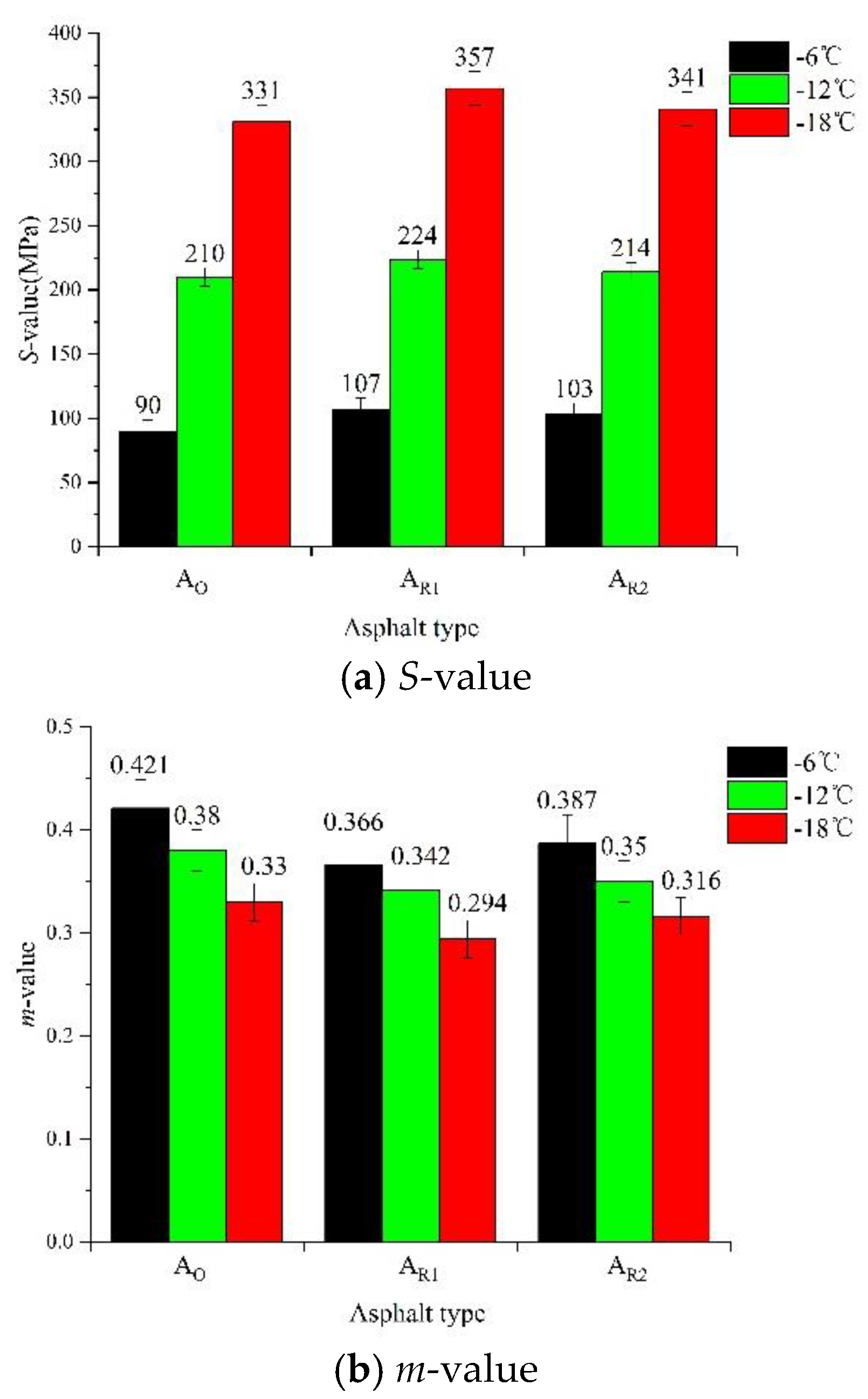
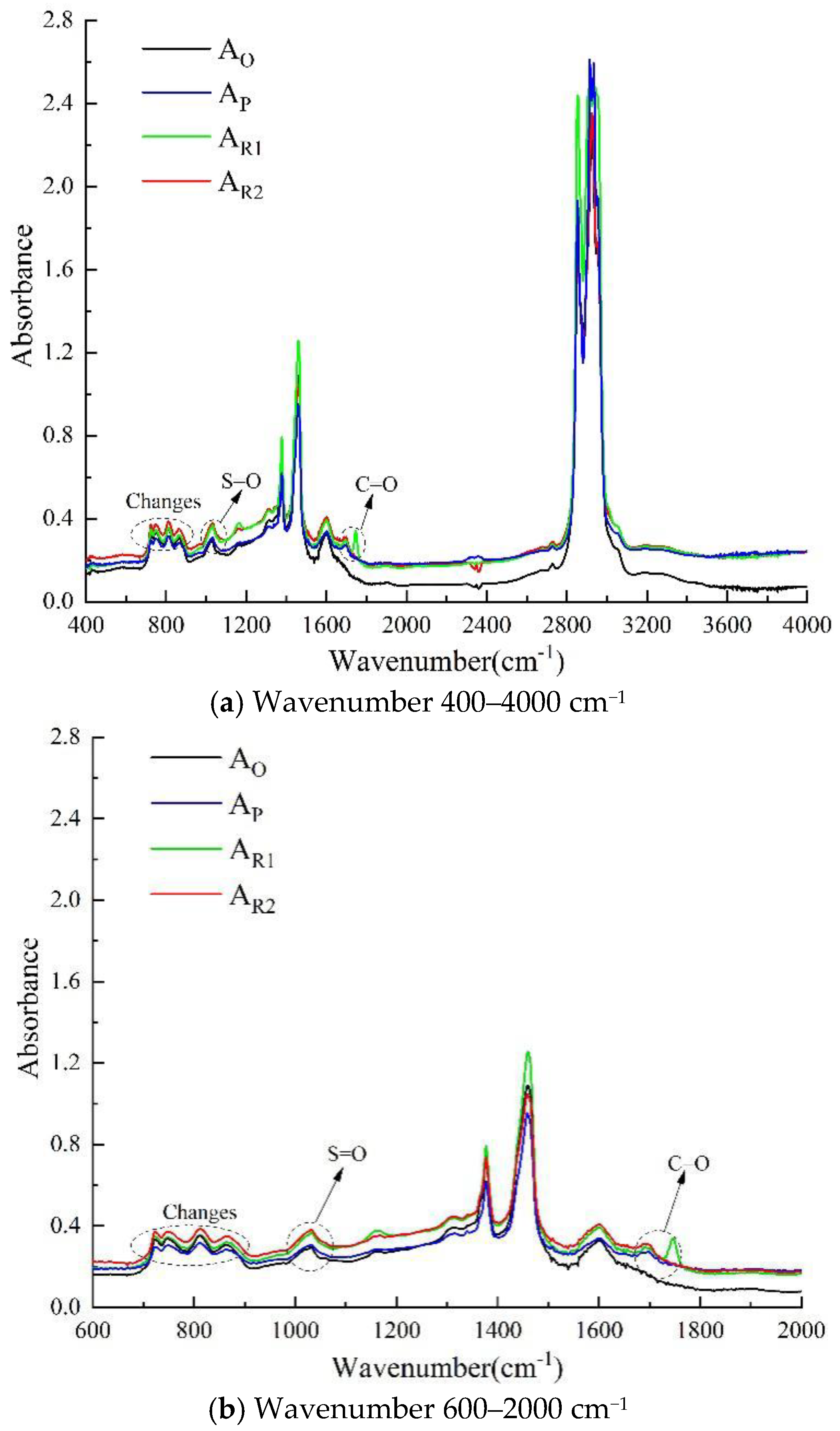

| Property | Unit | 70# Matrix Asphalt |
|---|---|---|
| Penetration (25 °C) | 0.1 mm | 64 |
| Penetration index | - | −0.124 |
| Softening point | °C | 48 |
| Ductility (15 °C) | cm | 117 |
| Viscosity (135 °C) | Pa·s | 0.34 |
| Category | Content (%) | Test Method | |
|---|---|---|---|
| Physical property | Moisture | 7.0 | Dry weightlessness method |
| Volatile matter | 90.9 | ||
| Fixed carbon | 0.2 | Slow ashing | |
| Ash | 1.9 | ||
| Elementary composition | C | 46.90 | Elemental analysis |
| H | 5.84 | ||
| N | 0.22 | ||
| S | 0.03 | ||
| Ob | 47.01 | ||
| Composition | Cellulose | 41.0 | Van Soest |
| Hemicellulose | 25.7 | ||
| Lignin | 26.1 | ||
| Property | Measured Value | Specified Value |
|---|---|---|
| Viscosity (60 °C, Pa·s) | 5370 | 50–60000 |
| Flash point (°C) | 241 | ≥220 |
| Saturates content (%) | 20.3 | ≤30 |
| Aromatics content (%) | 64.2 | - |
| Viscosity ratio before and after TFOT | 1.3 | ≤3 |
| Mass change before and after TFOT (%) | 0.5 | −3~3 |
| Type | Absorption Peak Location (cm−1) | Vibration Form | Effects on Asphalt Properties |
|---|---|---|---|
| Carboxylic acid | 1700–1725 | Stretching vibration | Rutting resistance [49] |
| Aldehyde | 1720–1740 | Stretching vibration, strong intensity | Rutting resistance and fatigue property [50] |
| Amide | 1640–1690 | Stretching vibration, strong intensity | Improve adhesion [51] |
| Anhydride | 1740–1775 and 1800–1830 | Stretching vibration, two bands | Improve adhesion [51] |
| Ester | 1735–1750 | Stretching vibration, strong intensity | Improve adhesion [52] |
| Ketone | 1665–1715 | Stretching vibration, strong intensity | Increase the viscosity [47] |
| Serial Number | Factors and Levels (%) | Test Index | |||||
|---|---|---|---|---|---|---|---|
| Wood Tar | Biomass Fiber | Plasticizer | Penetration (25 °C, 0.1 mm) | Softening Point (°C) | Ductility (15 °C) | Viscosity (135 °C, Pa·s) | |
| S-1 | 5 | 0.3 | 2 | 43 | 65 | 60.0 | 0.52 |
| S-2 | 5 | 0.4 | 3 | 42 | 67 | 59.3 | 0.53 |
| S-3 | 5 | 0.5 | 4 | 46 | 68 | 64.2 | 0.55 |
| S-4 | 5 | 0.6 | 5 | 43 | 69 | 60.1 | 0.56 |
| S-5 | 10 | 0.3 | 3 | 60 | 54 | 90.1 | 0.51 |
| S-6 | 10 | 0.4 | 2 | 59 | 57 | 74.1 | 0.53 |
| S-7 | 10 | 0.5 | 5 | 62 | 58 | 85.7 | 0.54 |
| S-8 | 10 | 0.6 | 4 | 64 | 61 | 69.8 | 0.55 |
| S-9 | 15 | 0.3 | 4 | 73 | 49 | 114.0 | 0.40 |
| S-10 | 15 | 0.4 | 5 | 68 | 51 | 118.3 | 0.43 |
| S-11 | 15 | 0.5 | 2 | 59 | 54 | 108.4 | 0.47 |
| S-12 | 15 | 0.6 | 3 | 60 | 56 | 101.4 | 0.48 |
| S-13 | 20 | 0.3 | 5 | 78 | 46 | 121.2 | 0.34 |
| S-14 | 20 | 0.4 | 4 | 64 | 48 | 116.0 | 0.38 |
| S-15 | 20 | 0.5 | 3 | 61 | 54 | 107.3 | 0.39 |
| S-16 | 20 | 0.6 | 2 | 60 | 56 | 103.2 | 0.40 |
| Property | AO | AP | AR1 | AR2 | Specification Requirement |
|---|---|---|---|---|---|
| Penetration (25 °C, 0.1 mm) | 64 | 20 | 64.5 | 63 | 60–80 |
| Softening point (°C) | 48 | 85.3 | 57 | 55 | ≥46 |
| Ductility (15 °C, cm) | 117 | 21 | 102 | 113 | ≥100 |
| Viscosity (135 °C, Pa·s) | 0.34 | 0.93 | 0.42 | 0.48 | - |
| Asphalt Type | Composition (%) | IC | |||
|---|---|---|---|---|---|
| Asphaltene | Colloid | Saturates | Aromatics | ||
| AO | 11.01 | 25.37 | 14.31 | 48.35 | 0.34 |
| AP | 16.30 | 31.28 | 14.25 | 38.14 | 0.44 |
| AR1 | 12.79 | 26.71 | 15.18 | 43.25 | 0.40 |
| AR2 | 12.40 | 24.37 | 14.30 | 44.87 | 0.39 |
© 2020 by the authors. Licensee MDPI, Basel, Switzerland. This article is an open access article distributed under the terms and conditions of the Creative Commons Attribution (CC BY) license (http://creativecommons.org/licenses/by/4.0/).
Share and Cite
Zhang, X.; Zhu, J.; Wu, C.; Wu, Q.; Liu, K.; Jiang, K. Preparation and Properties of Wood Tar-based Rejuvenated Asphalt. Materials 2020, 13, 1123. https://doi.org/10.3390/ma13051123
Zhang X, Zhu J, Wu C, Wu Q, Liu K, Jiang K. Preparation and Properties of Wood Tar-based Rejuvenated Asphalt. Materials. 2020; 13(5):1123. https://doi.org/10.3390/ma13051123
Chicago/Turabian StyleZhang, Xuefei, Juncai Zhu, Chaofan Wu, Qingding Wu, Kefei Liu, and Kang Jiang. 2020. "Preparation and Properties of Wood Tar-based Rejuvenated Asphalt" Materials 13, no. 5: 1123. https://doi.org/10.3390/ma13051123
APA StyleZhang, X., Zhu, J., Wu, C., Wu, Q., Liu, K., & Jiang, K. (2020). Preparation and Properties of Wood Tar-based Rejuvenated Asphalt. Materials, 13(5), 1123. https://doi.org/10.3390/ma13051123




